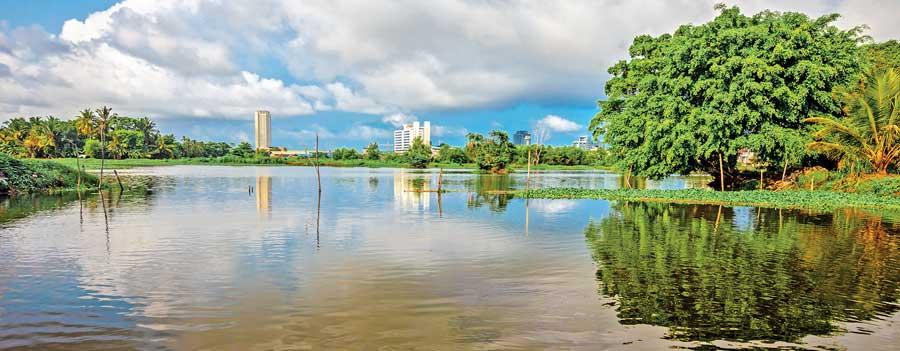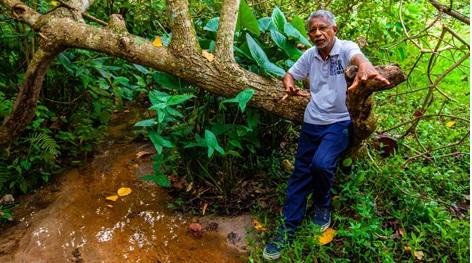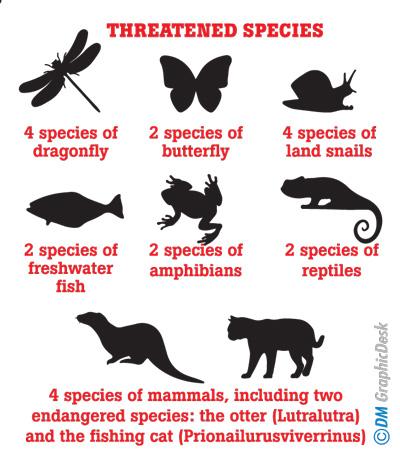Reply To:
Name - Reply Comment
Last Updated : 2024-04-16 07:29:00

At the Daily Mirror, we believe that climate change is one of the greatest threats that we, as Sri Lankans, will face in the future. Therefore, we intend to provide our readers with local and international content with the objective to educate and inspire. We would also like to learn from our valued readers about any ongoing initiatives in making Sri Lanka a more sustainable nation.
We aim to explore sustainable ways of living that have the most positive impact on not just our natural environment, but also for humans and animals.
While topics such as global warming, pollution, and inequality are confronting, we believe it's time the media stopped shying away from these issues and became an active participant in finding solutions - and we hope you will join us.

Seventy-year-old Indrapala Gamarachchi looks out over one of the last remaining patches of wilderness in his neighbourhood. He believes this land in Mattegoda, just south-east of Colombo city, deserves to be a Gazetted, protected wetland.

Not only is it a catchment area - the water that collects here feeds a stream that irrigates some 200 urban paddy fields downstream – but it is also one of the last remaining havens for wildlife. But it is clear, it needs attention. At one end, a garbage dump seems to swell in size by the day, and at the other, you can see some homes on its borders are channelling wastewater into the once pristine space.
Indrapala has lived in Mattegoda for 30 years and has watched with dismay as the Mattegoda weva and adjacent wetlands have come under threat from relentless development. He decided to do something about it, and as the President of the Wetland Management Committee, he is working closely with the Public Interest Law Foundation to bring these lands under the protection of the Central Environment Authority. As part of their efforts, they are commissioning a biodiversity survey to explore how many species live here, and are rallying the surrounding community to preserve this precious resource.
“These are the only places left where the future generations can come to learn about plants and animals the role of the wetland. That is why we must preserve it,” says Indrapala.
The importance to Colombo

Mihiri Gunawardene, Director of the Public Interest Law Foundation agrees, and adds that these wetlands could use the government’s attention and protection. Mihiri notes that current environmental laws should be enough to protect these spaces, but implementation has always been the real challenge.
“Because this is an urban context, it is important we have the development agencies involved,” she says, explaining that the debate tends to boil down to two sides: development versus conservation.
It is a conflict that is playing out across the city. The Mattegoda weva and adjacent wetlands are a part of a rich, vital network that make up the urban wetlands of Colombo. Stretching out over some 20 km2, they represent 2.9 percent of the total land area of Colombo District. Their importance to Colombo is hard to overstate.
Wetlands: The lungs of a city
Wetlands can serve as the lungs of a city, helping clear atmospheric pollutants and lower temperatures in their environs. They also support rice and vegetable cultivation, alongside dairy cattle. Foragers find in their depths a nourishing variety of medicinal herbs, leafy vegetables and native plants. The streams and lakes are also a source of freshwater fish, providing fisherman across the region a livelihood.
Wetlands remain one of the city’s biggest defences against flooding. During intensive rainfall events, the wetlands can store tens of millions of cubic meters of water. The wetlands are mitigating global climate change as well. Estimates suggest that the wetland soils contain approximately 1.43 million metric tons of carbon (almost 90 percent of the annual carbon emissions from the Colombo Metropolitan Region).
Among the endemic vertebrate species, 60 per cent are threatened nationally. These include four species of dragonfly, two species of butterfly, four species of land snails, two species of freshwater fish, two species of amphibians, two species of reptiles, and four species of mammals, including two endangered species: the otter (Lutra lutra) and the fishing cat (Prionailurus viverrinus)
Attempts are now being made to protect these significant yet fragile ecosystems under the United Nations Development Programme (UNDP) - Global Environment Facility (GEF) funded Small Grants Programme, which is in its sixth operational phase. The $2.5 million, the four-year project extends up until November 2020 and is designed to enable community organizations to take collective action for adaptive landscape management.
As part of the programme, the wetlands in the south-east region of the Colombo district have been selected as a pilot landscape. The area which encompasses 14 wetlands and 32 villages spans the DS divisions of Maharagama, Kaduwela, Kolonnawa, Homagama and Seethawaka.
Little attention has been paid to these wetlands in the past, and they are rapidly degrading due to a combination of factors including pollution and siltation from unsustainable land-use practices including deforestation, waste disposal, agricultural run-off, over-extraction of water for irrigation, unsustainable fishing practices, unauthorized encroachment and land reclamation.
52-year-old Shantha Jayaweera is the president of the Organization for Aquatic Resources Management can see that the Heen Ela wetlands are under attack from many sides. He can often be found on a basic catamaran, floating down the canals that flow around the three islands at its heart. On Heen Ela’s borders, small homes encroach on the land and dump household waste and other pollutants, and in the wetlands themselves, invasive species are overwhelming native plants and animals.

Protectors of the Wetlands
Through his organization, Shantha hopes to recruit local communities as protectors of the wetlands, by helping them find livelihoods in eco-tourism and handicraft sector. He is working to rehabilitate 60 hectares of the Heen Ela marshes through replanting native species and is also attempting to reduce human-snake conflict by introducing dens on high ground where animals can take refuge in rainy weather, keeping them out of homes and buildings. Bat dens have also been constructed for Fruit Bats (Pteropodidae) and Micro-bats (Microchiroptera) that are key to keeping mosquitoes under control here.
Wetlands can serve as the lungs of a city, helping clear atmospheric pollutants and lower temperatures in their environs. They also support rice and vegetable cultivation, alongside dairy cattle. Foragers find in their depths a nourishing variety of medicinal herbs, leafy vegetables and native plants. The streams and lakes are also a source of freshwater fish, providing fisherman across the region a livelihood
“The people don’t understand the value of the wetlands,” he says.
“Most capital cities don’t have such beautiful natural environments just a short walk away.”
And it’s not just humans who would suffer if these wetlands were destroyed. These marshes are home to a wide variety of animals - some 209 species of vertebrates were recorded here of which 17 are endemic, while 26 are nationally threatened (IUCN Sri Lanka, 2000).
 Nationally threatened species
Nationally threatened species
Among the endemic vertebrate species, 60 per cent are threatened nationally. These include four species of dragonfly, two species of butterfly, four species of land snails, two species of freshwater fish, two species of amphibians, two species of reptiles, and four species of mammals, including two endangered species: the otter (Lutra lutra) and the fishing cat (Prionailurus viverrinus).
It is the latter that fascinates Anya Ratnayake. Anya’s work is targeted at protecting the endangered fishing cat. The charismatic animal is the largest terrestrial predator in these parts, but sightings are very rare.
However, as the cats are an apex predator, the health of their population can provide vital clues to the vitality of the ecosystem as a whole. By setting up camera traps and studying the animals, Anya is hoping to understand more about the habits of these elusive animals. Having fallen in love with fishing cats herself, she knows they could be a big draw for tourists. Tourists would mean more jobs and a better chance that this delicate ecosystem could survive growing urbanization. “The fishing cat is really a flagship species for wetland conservation,” says Anya, simply.
Battle against the clock
Working from different perspectives, Mihiri, Shantha and Anya are all focused on the preservation of something they see as being a defining characteristic of this city. However, they are in a battle against the clock. While rates of loss vary across the district, in a number of areas the loss of wetlands since the 1980s has been as high as 60 percent. Every year, we lose another 1.2 percent. Without action to address the drivers of loss, Colombo Wetlands could be reduced by one-third by 2038 and by half by 2070.
However, there is hope if only the city recognizes what it has before the wetlands disappear. “Colombo has survived because of the wetlands for centuries,” says Anya. “Let’s preserve them for future generations.”
UNDP Exclusive for Dailymirror
Rex Saturday, 08 February 2020 02:40 PM
Good, insiteful article. Let's hope that we take an active interest before it's too late.

Add comment
Comments will be edited (grammar, spelling and slang) and authorized at the discretion of Daily Mirror online. The website also has the right not to publish selected comments.
Reply To:
Name - Reply Comment
On March 26, a couple arriving from Thailand was arrested with 88 live animal
According to villagers from Naula-Moragolla out of 105 families 80 can afford
Is the situation in Sri Lanka so grim that locals harbour hope that they coul
A recent post on social media revealed that three purple-faced langurs near t
09 Apr 2024 - 1 - 1161
25 minute ago
1 hours ago

10 Apr 2024
09 Apr 2024